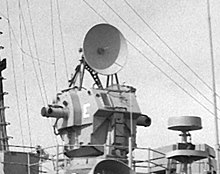Gun Fire Control Systems

Mark 68 GFCS director with AN/SPG-53 radar antenna on top.
|
|
| Country of origin | United States |
|---|---|
| Type | Gun fire-control |
| Precision | Fire control quality, three dimensional data |
Ship gun fire-control systems (GFCS) enable remote and automatic targeting of guns against surface ships, aircraft, and shore targets, with or without the aid of radar or optical sighting. Most US ships that are destroyers or larger (but not destroyer escorts or escort carriers) employed GFCS for 5 -inch and larger guns, up to battleships, such as the USS Iowa. Beginning with ships built in the 1960s, GFCSs were integrated with missile fire-control systems and other ship sensors.
The major components of a GFCS are a manned director, with or replaced by radar or television camera, a computer, stabilizing device or gyro, and equipment in a plotting room
For the USN, the most prevalent gunnery computer was the Ford Mark 1, later the Mark 1A Fire Control Computer, which was an electro-mechanical analog ballistic computer that provided accurate firing solutions and could automatically control one or more gun mounts against stationary or moving targets on the surface or in the air. This gave American forces a technological advantage in World War II against the Japanese who did not develop Remote Power Control for their guns; both the USN and IJN used visual correction of shots using shell splashes or air bursts, while the USN augmented visual spotting with Radar. Digital computers would not be adopted for this purpose by the US until the mid-1970s; however, it must be emphasized that all analog anti-aircraft fire control systems had severe limitations, and even the USN Mk 37 system required nearly 1000 rounds of 5" mechanical fuze ammunition per kill, even in late 1944.
The MK 37 Gun Fire Control System incorporated the Mk 1 computer, the Mk 37 director, a gyroscopic stable element along with automatic gun control, and was the first USN dual purpose GFCS to separate the computer from the director.
Naval fire control resembles that of ground-based guns, but with no sharp distinction between direct and indirect fire. It is possible to control several same-type guns on a single platform simultaneously, while both the firing guns and the target are moving. Though a ship rolls and pitches at a slower rate than a tank does, gyroscopic stabilization is extremely desirable. Naval gun fire control potentially involves three levels of complexity:
...
Wikipedia
